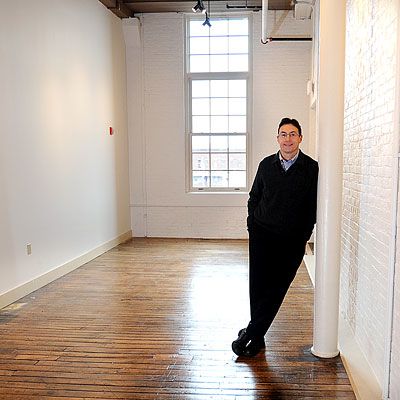Q&A: Developer Nathan Szanton talks about his Bates Mill project
 photo/Amber Waterman
Nathan Szanton, of Portland development firm Szanton and Co., relishes rehabilitating old mill buildings into modern housing, such as The Lofts at Bates Mill in Lewiston pictured here
photo/Amber Waterman
Nathan Szanton, of Portland development firm Szanton and Co., relishes rehabilitating old mill buildings into modern housing, such as The Lofts at Bates Mill in Lewiston pictured here
Developer Nathan Szanton's latest project — The Lofts at Bates Mill in Lewiston — brings him deep satisfaction on two counts: it revives a long-vacant mill building and more than half the apartments he built were rented before it formally opened.
By its Nov. 8 grand opening, the $9.2 million project had 32 of its 48 apartments claimed.
"I don't view old mill buildings as hurdles to economic development or a lead ball around our feet," he says. "I think they must be viewed as an engine of economic development."
Mainebiz recently sat down with Szanton to talk about the project. The following is an edited transcript.
Mainebiz: Can you walk us through your process of deciding whether a project is viable?
Szanton: First, there's the purchase price. It has to be low enough to make the numbers work. Secondly, can we bring to bear some forms of financing that don't need to be repaid? If we have to do it all with debt, that's usually a nonstarter.
What financing did you use for The Lofts at Bates Mill?
We had three kinds of tax credits that substituted for debt. We used two kinds of historic tax credits: the federal credits that have been around since the 1970s — a 20% tax credit on qualified rehabilitation expenses that can be used with federal income tax liability — and the state historic tax credit, which in 2008, had its cap increased to $5 million per project. That opened the floodgates for these kinds of projects. The third credit was the low-income housing tax credit. [It involves] a mortgage deferral that helps us keep rents low. If it weren't for the tax credit programs, we would have needed to charge $2,000 a month to make the project work and no one would be willing to pay that.
How did you end up in this niche?
It was pretty serendipitous. I was trained as a lawyer and after three years of practice realized it wasn't making me happy. I was interested in real estate, but in 1993 there was a real estate depression and developers weren't hiring, but I found a job with the Maine State Housing Authority as a loan officer. I learned everything I could about affordable housing — about LIHTC and how it works, about appraisals, loan-to-value ratios and creating financial projections for real estate developments. I found I loved it. From there, I realized there was a shortage of affordable housing consultants, so in 1996 I started Szanton and Co. to help nonprofits put together housing projects. I did that for six years and, in 2002, met Bobby Monks and together we started a company to do real estate developments.
Were there any aspects to the Bates Mill development that were particularly challenging, or gratifying?
Yes, it was especially challenging that I owned only 40% of Bates Mill No. 2. It meant I had to negotiate a very complicated condominium document, and it was a challenge with one of my funders who felt I didn't have enough control of the overall complex [to substantiate the collateral]. There was compromise, but we were able to work it out. On the other side, I found it especially satisfying to see the physical difference in the building from what it was to what it is now. It was also really gratifying to help Lewiston — which went through such tough economic times in the '60s and '70s — get back on its feet. Those 100 or so tenants at The Lofts are each a little economic development engine — they eat at local restaurants, buy things at local shops, use local banks. It's great to help Lewiston regain its momentum. n










Comments